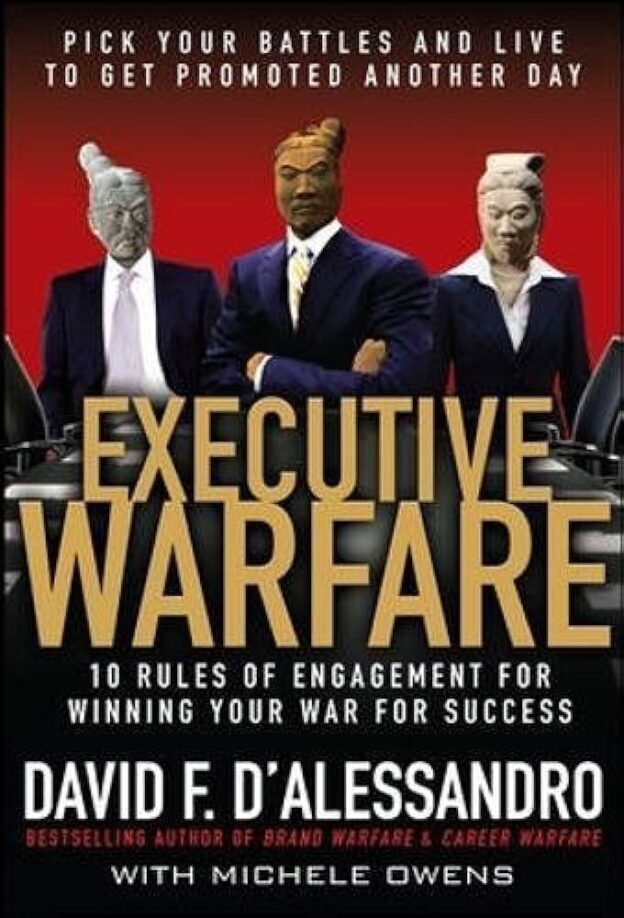“Executive Warfare: 10 Rules of Engagement for Winning Your War for Success” is yet another book in David F. D’Alessandro’s series focusing on strategies for success in the corporate world. Here’s a brief Synopsis and Critical Analysis.
Synopsis of “Executive Warfare: 10 Rules of Engagement for Winning Your War for Success” by David F. D’Alessandro
“Executive Warfare” zeroes in on the world of executive leadership, where the stakes are high, and the corporate battles are fiercest. D’Alessandro, drawing from his expansive experience at the top echelons of corporate America, offers a candid and insightful guide for those looking to ascend to executive roles and thrive once they get there.
The book is built around ten key rules of engagement:
- Your Boss Is the Most Important Person in the World: Recognizing and managing upwards is a vital strategy, emphasizing the need to build a strong relationship with those in power.
- Always Remember They Hate You: Paranoia can be beneficial. D’Alessandro reminds executives that the higher they rise, the more enemies they might accumulate, often silently.
- It’s All on the Record: In the world of smartphones and constant communication, discretion is paramount. Every interaction could potentially be used against an executive.
- Make Sure You Have a Life (Or at Least a Good Story): Personal narratives are powerful. An interesting personal story can make executives more relatable and memorable.
- Never Let Anyone See You Sweat: Portraying confidence, even in the face of adversity, can cement an executive’s position of authority and leadership.
- Beware the Too-Loyal Number Two: Loyalty is valuable, but over-dependence or blind trust in a subordinate can be a hidden pitfall.
- Avoid the Dangerous Threesome: Money, relationships, and power create a volatile mix. Navigating them with caution and integrity is crucial.
- Always Be Graceful Under Pressure: How an executive handles crises can define their leadership. Grace and poise in challenging times are essential.
- Know the Business Better Than Anyone Else: Deep, comprehensive knowledge of one’s industry and company is a non-negotiable for executive success.
- Never Underestimate the Power of Enthusiasm: Authentic passion and enthusiasm can inspire teams, win over stakeholders, and drive success.
D’Alessandro combines these rules with illustrative anecdotes, cautionary tales, and personal experiences, crafting a book that’s both a guide and a playbook. “Executive Warfare” is aimed at those already in leadership roles or those aspiring to break into the C-suite, offering strategies to navigate the nuanced challenges of executive leadership.
Critical Analysis of “Executive Warfare: 10 Rules of Engagement for Winning Your War for Success” by David F. D’Alessandro
Strengths:
- Deep Corporate Insight: With D’Alessandro’s extensive experience in executive roles, “Executive Warfare” offers genuine insights into the world of top-tier corporate leadership. His firsthand knowledge gives the book an authoritative voice.
- Practicality: The ten rules of engagement are not just theoretical; they come with actionable advice. This practical orientation can help readers implement the strategies effectively.
- Rich Anecdotal Content: D’Alessandro’s use of anecdotes, both from his personal experience and broader corporate tales, enriches the narrative, making abstract principles tangible and relatable.
- Broad Applicability: While the primary audience is current or aspiring executives, many of the book’s principles can be valuable for mid-level professionals and even those outside the corporate sphere.
Areas for Improvement:
- Over-Emphasis on Caution: While the book stresses the importance of being wary (e.g., “Always Remember They Hate You”), this could instill an overly cautious or even paranoid approach in some readers. Balance is crucial in any leadership role, and fostering trust can be as important as being wary.
- Cultural & Temporal Relevance: The corporate landscape is evolving, with a greater emphasis on diversity, inclusion, and progressive values post-2021. The book might not fully capture the nuances of this newer corporate culture.
- Subjectivity: As with D’Alessandro’s other works, the advice is rooted in personal experience. While this lends authenticity, it also introduces subjectivity. What worked for D’Alessandro might not work universally for everyone.
- Lack of Emphasis on Ethical Leadership: While the book offers strategies to succeed in the corporate battle, there’s a potential for readers to misconstrue some advice as endorsing a “win at all costs” mentality. An explicit emphasis on ethical leadership would be beneficial.
Conclusion:
“Executive Warfare” serves as a valuable guide for those navigating the intricate world of executive leadership, offering strategies derived from D’Alessandro’s own journey. However, readers should approach the book critically, adapting its lessons to their unique contexts and ensuring that success is pursued with integrity and ethical considerations.
